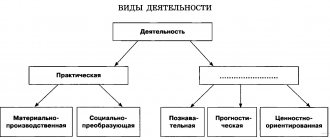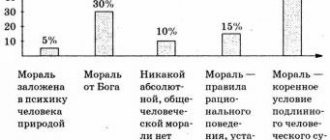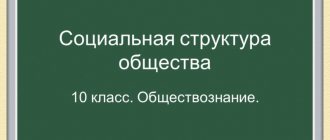Right: 10th grade. Test: form of state test in social studies (grade 10) on the topic
Test "Form of State". Option 1.
A1. The activity of one political party is prohibited in the state. What additional information will allow us to draw a conclusion about the features of the political regime that exists in this state?
1) the degree of monopolization of the economy 2) the method of electing the head of state
3) the goals of a given political party 4) the structure of the legislative body
A2. A political regime characterized by strict control over society, the inculcation of official ideology, and the persecution of dissent is called
1) authoritarianism 2) voluntarism 3) totalitarianism 4) absolutism
A3. An independent judiciary is a necessary element of which political regime?
1) authoritarian 2) totalitarian 3) theocratic 4) democratic
A4. In the state of Georgia, during voting, citizens receive lists of political parties competing for seats in parliament. According to the law, the winners will be parties that receive at least 7% of the votes; Among the candidates for deputy in a given constituency, only one, if he wins, will be able to take a seat in parliament. What kind of electoral system exists in this state?
1) mixed 2) majoritarian 3) proportional 4) multi-member
A5. One of the functions of democratic political power is
1) suppression of resistance from the dissatisfied part of the country’s population
2) retention of power in the hands of one political force
3) ensuring the influence of the ruling elite on all spheres of public life
4) search for mechanisms to ensure social stability
A6. In the state of N., people actively go to the polls. Political power widely uses coercion, many media are financed from the state budget, the army is vested with great powers, citizens must support the state ideology approved by the ruling party. What type of political regime exists in this state?
1) democratic 2) anarchist 3) authoritarian 4) nationalist
A7. Are the judgments about the elections correct?
A. An accurate and clear procedure for holding elections is a decisive condition for the development of democracy.
B. In elections under a majoritarian electoral system, there is a close connection between voters and deputies: 1) A is correct 2) B is correct 3) both are correct 4) both are incorrect
A8. As a result of the parliamentary elections in the state of M., a political crisis arose, the cause of which was disagreement over the presidential candidacy that arose between the two parties that won the elections with a minimal gap. What form of government exists in the state of M?
1) presidential republic 2) constitutional monarchy
3) parliamentary republic 4) mixed republic
A9. Are the judgments about a parliamentary republic correct?
A. In a parliamentary republic, the leading position in the system of government bodies belongs to the president.
B. A parliamentary republic differs from a presidential republic in less political stability.
1) A is true 2) B is true 3) both are true 4) both are false
A10. There are two lists of candidates in the electoral district - from party S. and from party N. 180 thousand voters took part in the voting. Mandates between parties were distributed in accordance with the number of votes cast for it. What electoral system were used for elections in this constituency? 1) majoritarian 2) proportional 3) mixed 4) single-member
A11. Are the judgments about electoral systems correct?
A. In a proportional system, only one candidate is elected from each electoral district.
B. In a majoritarian system, the absolute majority of votes is won by the candidate for whom at least 50% + 1 voter voted. 1) A is true 2) B is true 3) both are true 4) both are false
AT 3. Match.
| Signs | Types of watering modes |
| A) power is exercised by a narrow group of people B) equality of all before the law is guaranteed C) citizens are given the right to diversity in public organizations D) power and order are valued more than human rights and freedoms D) a special role belongs to such institutions as the army and the church E) state control is exercised over the sphere of politics and the spiritual life of society | 1) democratic 2) authoritarian |
Test "Form of State". Option 2.
A1. In country M, after a long reign of a military dictator, democratically elected forces came to power. At the founding constitutional congress, a new constitution of the country was adopted, which consolidated the democratic foundations of the state. Which article must be present in the constitution of country M?
1) Ideological pluralism has been proclaimed in the country as the leading principle of political life.
2) The president of the country is elected by both houses of parliament for a five-year term.
3) Deputies from parties that received at least 10% of the votes in the elections enter the lower house of parliament, the House of People's Representatives.
4) The government of the country regularly reports on its activities to the president.
A2. Political reforms are taking place in the country of N. Journalists and analysts assess them as democratic. What situation in the ongoing reforms could cause such an assessment by specialists?
1) The tenure of deputies of the Legislative Assembly has been increased from 4 to 5 years.
2) Instead of a majoritarian electoral system, a mixed one was introduced.
3) The equal rights of all participants in the election campaign and their access to the media are guaranteed by law.
4) A 5% electoral threshold has been established for parties to enter parliament.
A3. A referendum was held in the country of N. on the adoption of a new constitution. As a result of its adoption, the country of N. became a federal state. What article must be contained in the N. constitution?
1) power belongs to the people who elect their representatives
2) citizens are guaranteed freedom of conscience and religion
3) sovereign rights are distributed between the center and regions
4) the president of the country is elected by an electoral college for a term of 4 years
A4. The goal of the policy of a modern state in the field of development of political processes and institutions is
1) strengthening representative democracy, expanding the participation of the people in the preparation and adoption of laws.
2) protection of the poor, vulnerable segments of the population, targeted support for youth and the elderly.
3) protecting domestic producers from competition from foreign producers.
4) weakening of the tax burden on small and medium-sized businesses, preferential taxation of small enterprises.
A5. The highest legislative body in the state of Palestine is formed by election. What additional information would allow us to conclude that this state has a democratic political regime?
1) Elections of parliamentarians are carried out by voters directly, and not through electors.
2) Candidates for deputies have equal conditions in presenting their programs in the media.
3) In the structure of the deputy corps, a quota for the representation of women is allocated in advance.
4) Citizens have the opportunity to vote using absentee ballots and early.
A6. Are the following statements about the state correct?
A. The leading institution of the political system, designed to ensure the stability of society, is the state.
B. The state has the exclusive right to use force against those who violate the law.
1) only A is true 2) only B is true 3) both judgments are correct 4) both judgments are incorrect
A18. Which statement reveals one of the manifestations of national politics in a democratic society?
1) The state provides a person with the opportunity to determine his nationality.
2) The state does not interfere with the activities of organizations that proclaim the superiority of some ethnic groups over others.
3) The state provides the opportunity to obtain higher education only to representatives of national minorities.
4) The state introduces a special tax for those who do not profess the majority religion.
A7. A democratic regime is characterized
1) comprehensive state control over the life of society 2) the dominance of the executive branch
3) militarization of public life 4) political pluralism
A8. A democratic regime is characterized
1) administrative-command management methods 2) comprehensive control over the life of society
3) dominance of the executive branch 4) guarantees of minority rights
A9. In the state of A., supreme power belongs to the hereditary ruler. His power has no legal restrictions. He concentrates in his hands all the legislative, administrative and judicial powers. What is the form of government in this state?
1) mixed republic 2) parliamentary monarchy 3) presidential republic 4) absolute monarchy
A10. The head of state of N. is elected by a meeting of electors and performs representative functions. The government is formed by parliament and is responsible to it. The head of government is the prime minister. What form of government does this example illustrate?
1) parliamentary republic 2) absolute monarchy
3) presidential republic 4) parliamentary monarchy
C1. The French educator of the 18th century, Montesquieu, positively assessed the republic and monarchy, contrasting them with despotism. At the same time, the thinker did not turn a blind eye to the vices of these forms of government. Indicate what positive and what negative features do monarchical and republican forms of government contain?
Test on the topic “Form of State”
Author: andryushkevitchyulia · Published 01/13/2018 · Updated 03/18/2018
State form
- In State H there is a hereditary transfer of royal power. Elections to parliament, which performs legislative functions, are held regularly on an alternative basis. Citizens have full rights and freedoms, and civil society institutions are developed. State N includes territorial units that do not have political independence. Find the characteristics of the state form H in the list below and write down the numbers under which they are indicated. 1. Unitary state 2. Federal state 3. Absolute monarchy 4. Constitutional monarchy 5. Presidential republic 6. Democratic state
- State N unites several states that have their own parliaments, governments and legislation. In N, competitive elections to parliament are periodically held, which forms the government from representatives of the winning political party (bloc of parties). Members of parliament elect a president who performs representative functions. Select the characteristics of the state form H from the list below and write down the numbers under which they are indicated. 1. Presidential republic 2. Unitary state 3. Democratic state 4. Parliamentary republic 5. Authoritarian rule 6. Federal state
- State N is a federal republic. What additional information will help to conclude that a democratic political regime has been established in State H? Find the characteristics of country N in the list below and write down the numbers under which they are indicated. 1. The country implements the principle of separation of powers 2. Subjects of the federation have a certain political independence 3. Country N is divided into five regions 4. In country N, the rights and freedoms of citizens are guaranteed by law 5. Free elections are regularly held in the country on an alternative basis 6. On a political basis several parties compete in the arena
- The constitution of State N declares that State N is a democratic federal parliamentary republic. Which of the following features characterize the N form of government? Write down the numbers under which they are indicated. 1. The bicameral structure of parliament to ensure the representation of the subjects 2. The presence of several party factions in the parliament 3. The validity of the constitutions of the subjects under the supremacy of the general constitution 4. The government ensures law and order and the defense capability of the country 5. The head of state is elected by the parliament 6. The government is responsible to the parliament
- In State N, elections to local government bodies are regularly held on an alternative basis. What additional information would allow us to conclude that a democratic political regime has been established in State H? Find the characteristics of State H in the list below and write down the numbers under which they are listed. 1. The president is elected by members of parliament 2. Citizens have the right to establish new political parties or participate in the activities of existing parties 3. Parliament passes laws 4. Government policies depend on the results of elections and on the preferences of voters 5. Citizens have the right to freely express their political views 6. Head the state is the president
- In State N, supreme power belongs to the hereditary ruler, whose powers are limited by law. Elections to representative bodies are held regularly and on an alternative basis. The state is divided into administrative territorial entities that do not have sovereign rights. Determine the forms of state N. Write down the numbers under which they are indicated. 1. Absolute monarchy 2. Democratic political regime 3. Parliamentary monarchy 4. Federal state 5. Unitary state
- In State N, the head of state is popularly elected. Elections periodically change based on the results of free elections: the power of leaders is constitutionally limited. State N includes 14 regions with some political independence. The National Assembly has a bicameral structure, and counties have the right to adopt their own constitution. In country N, the principles of civil society and the rules of competition are implemented; individual rights and freedoms are proclaimed the highest value of the state. Based on the given facts, identify each of the three components of the state form N (be sure to first name the component of the state form, and then specify each of them for the state N).
- All official media of State N proclaim that State N is democratic. By what signs can it be established that State N really is such? Write down the numbers under which they are indicated. 1. The state actively protects state property 2. The state has a state monopoly on ideology 3. State N is a rule of law state 4. The state respects and protects human rights 5. There is a parliament in the country 6. The principle of political pluralism operates in the state
- In State N, the highest authorities are elected from bottom to top. The legal system ensures peaceful competition among various political forces in the struggle for power. There is freedom of the press, there is no censorship, and civil rights and freedoms are guaranteed. The principle of the rule of law is implemented in all spheres of public life. The provinces within the state of N have a certain political independence. Select the characteristics of this state from the list provided and write down the numbers under which they are indicated. 1. Unitary 2. Federal 3. Republican 4. Secular 5. Democratic 6. Legal
- In state N, its administrative territorial units have a certain political independence. There is union citizenship and citizenship of the subjects of the state N. The government is formed from the leaders of the party that won the elections by the parliament and is responsible to it. There is a multi-party system and ideological pluralism. Select from the list given the characteristics of the form of this state and write down the numbers under which they are indicated. 1. Unitary state 2. Democratic state 3. Federal state 4. Semi-presidential republic 5. Authoritarian state 6. Parliamentary republic
- In State H, the president is the head of state, having only nominal powers. In fact, his powers are exercised by the head of government, concentrating power in the executive body. At the same time, the people are removed from the real levers of state power. The basis of the legal system of a given state is a single constitution. There is partial pluralism, an imitation of a multi-party system. Select from the list given the characteristics of the form of this state and write down the numbers under which they are indicated. 1. Federal state 2. Authoritarian state 3. Presidential republic 4. Democratic state 5. Unitary state 6. Parliamentary republic
- In State N there is a separation of powers. Legislative power belongs to parliament. The appointment of the head of government is formally carried out by the Sultan, but taking into account parliamentary elections. The boundaries of administrative territorial units are established and changed by the center. Law reigns in all spheres of public life. The rights and freedoms of humans and citizens are proclaimed and actually ensured. Select from the list given the characteristics of the form of this state and write down the numbers under which they are indicated. 1. Absolute monarchy 2. Democratic state 3. Authoritarian state 4. Parliamentary monarchy 5. Unitary state 6. Federal state
- State N is a single, indivisible state formation with a single citizenship, leaving one whole. Legislative power is divided between the monarch and parliament. Executive power is exercised by the monarch. Political opposition is not allowed in the state, but individual autonomy is provided in the foreign policy sphere. Select from the list the characteristics of the form of this state and write down the numbers under which they are indicated. 1. Authoritarian state 2. Constitutional monarchy 3. Federal state 4. Dualistic monarchy 5. Unitary state 6. Totalitarian state
- In State D, the bearer of political power is the state elected bodies, and ultimately, the people who appoint these bodies during the election process. Economic and legal conditions are being created to ensure a decent life and free development of people, and a set of measures is being implemented to support the poor and low-income segments of the population. The rule of law and legal norms establishing the natural, inalienable, universal rights and freedoms of man and citizen are strictly observed. Select the characteristics of this state from the list provided and write down the numbers under which they are indicated. 1. Federal 2. Legal 3. Monarchical 4. Republican 5. Social 6. Secular
- In state A, there is a monopolization of state power by the ruling party and its concentration in the hands of the leader. There is control over the behavior and consciousness of citizens, significant restrictions on individual rights and freedoms, and dissent is severely punished. The highest bodies of state power are formed by national representative institutions. There is no state religion. Select the characteristics of this state from the list provided and write down the numbers under which they are indicated. 1. Secular 2. Unitary 3. Totalitarian 4. Democratic 5. Authoritarian 6. Republican
- In state N, its administrative territorial units are not endowed with political independence. The government is responsible to the president, who is elected by popular vote. The rights and freedoms of citizens are significantly limited, especially in the political sphere. The official ideology dominates, but the presence of other ideological currents is allowed. Select from the list the characteristics of the form of this state and write down the numbers under which they are indicated. 1. Federal state 2. Presidential republic 3. Unitary state 4. Totalitarian state 5. Democratic state 6. Authoritarian rule
- In State H there is a hereditary transfer of royal power. Elections to parliament, which performs legislative functions, are held regularly on an alternative basis. Citizens have full rights and freedoms, and civil society institutions are developed. State N includes territorial units that do not have political independence. Find the characteristics of the state form H in the list and write down the numbers under which they are indicated. 1. Constitutional monarchy 2. Presidential republic 3. Absolute monarchy 4. Unitary state 5. Federal state 6. Democratic state
- In State N, legislative power is exercised by parliament, and the popularly elected head of state forms the government and heads the executive branch. Citizens have full rights and freedoms, and civil society institutions are developed. State N includes the territories of subjects that have the right to adopt their own constitutions. Parliament has a bicameral structure. Find the characteristics of the state form H in the list and write down the numbers under which they are indicated. 1. Federal state 2. Democratic state 3. Absolute monarchy 4. Constitutional monarchy 5. Presidential republic 6. Unitary state
- In State N there is a hereditary transfer of power. The king's power is limited by the laws of the country. Parliamentary elections take place regularly on an alternative basis. Citizens have full rights and freedoms, and civil society institutions are developed. State N includes the territories of entities with partial sovereignty. Parliament has a bicameral structure, subjects have the right to adopt their own constitutions. Find the characteristics of the form of state in the list and write down the numbers under which they are indicated. 1. Unitary state 2. Federal state 3. Constitutional monarchy 4. Democratic state 5. Absolute monarchy 6. Presidential republic
- State N includes territories of subjects with a certain political independence. Citizens have full rights and freedoms, and civil society institutions are developed. In State N, legislative power is exercised by parliament, and the popularly elected head of state forms the government and heads the executive branch. Find the characteristics of the state form H in the list and write down the numbers under which they are indicated. 1. Federal state 2. Democratic state 3. Monarchy 4. Republic 5. Authoritarian state 6. Unitary state
- State N unites several states that have their own parliaments, governments and legislation. In N, free elections to parliament are periodically held, which forms a government from representatives of the winning political parties. Members of parliament elect a president who performs representative functions. Select the characteristics of the state form H from the list below and write down the numbers under which they are indicated. 1. Presidential republic 2. Unitary state 3. Democratic state 4. Parliamentary republic 5. Authoritarian rule 6. Federal state
- Head of State N receives power by inheritance. State N includes several territorial units that do not have political independence. The country has a multi-party system, the opposition operates on legal grounds. Find the characteristics of the state form H in the list and write down the numbers under which they are indicated. 1. Democratic 2. Republican 3. Totalitarian 4. Monarchical 5. Unitary 6. Federal
- In State N, citizens have full rights and freedoms, the institutions of civil society are developed; Elections of the head of state and parliament are held regularly. State N includes entities that have a certain political independence. Find the elements of State Form H in the list below and write down the numbers under which they appear. 1. Monarchy 2. Federation 3. Republic 4. Unitary state 5. Democratic state 6. Totalitarian state
- State N includes several entities with a certain independence; General, equal, direct elections of the head of state and parliament are regularly held based on secret ballot. The country represents a wide range of political ideologies; the rights and freedoms of citizens are guaranteed by law. Find the characteristics of State Form H in the list below and write down the numbers under which they are listed. 1. Monarchy 2. Republic 3. Federal state 4. Democratic state 5. Totalitarian state 6. Unitary state
Replies 1,146
- 346
- 1456
- 56
- 245
- 235
- Form of government - republic; form of state-territorial structure - federation; political regime – democracy 8.3456
- 2356
- 236
- 256
- 245
- 145
- 245
- 136
- 236
- 146
- 125
- 234
- 124
- 346
- 145
- 235
- 234
0
Author of the publication
offline 7 months
andryushkevitchyulia
4
Comments: 0Publications: 293Registration: 12/28/2017




